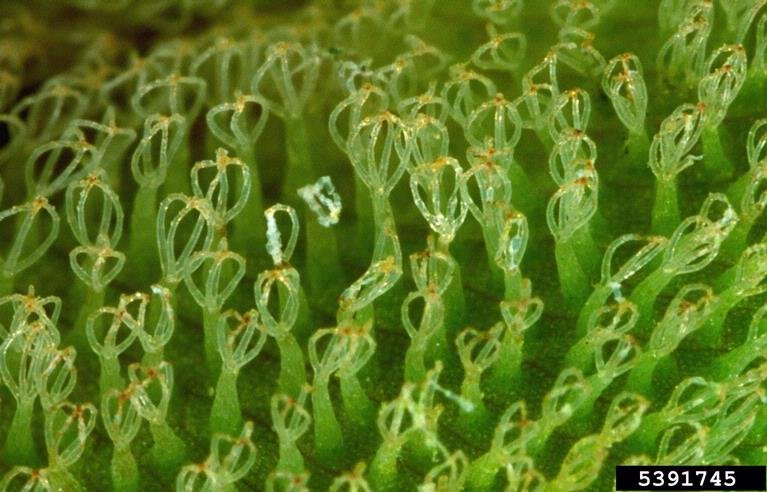
by Rick O'Connor | Mar 11, 2021
EDRR Invasive Species
Giant Salvinia (Salvinia molesta)
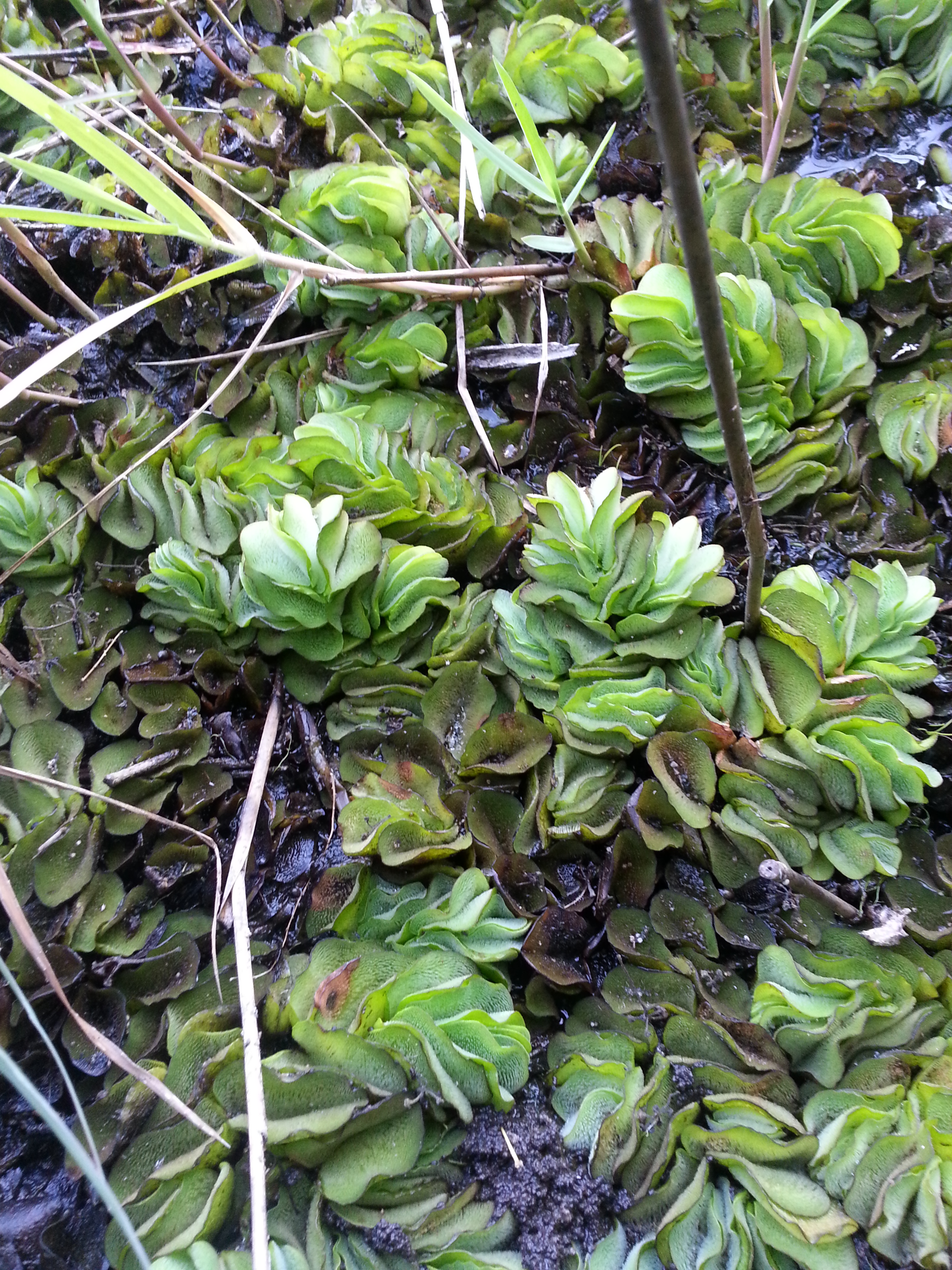
Active growing Giant Salvinia was observed growing out of the pond water on to moist soils and emerging cypress and tupelo tree trunks. Photo by L. Scott Jackson
Define Invasive Species: must have ALL of the following –
- Is non-native to the area, in our case northwest Florida
- Introduced by humans, whether intentional or accidental
- Causing either an environmental or economic problem, possibly both
Define EDRR Species: Early Detection Rapid Response. These are species that are either –
- Not currently in the area, in our case the Six Rivers CISMA, but a potential threat
- In the area but in small numbers and could be eradicated
Native Range:
Giant salvinia is from southeastern Brazil and northern Argentina.
Introduction:
Intentionally brought here as an aquatic ornamental plant in the 1990s.
EDDMapS currently list 1,090 records of this plant. Most of those records are from a small location at the lower end of the Colorado River on the Arizona/California border. The remainder are scattered across the southeastern United States. There are 14 records in the state of Florida. Three in south Florida, 11 in north Florida and nine of those are from Escambia County. All records in Escambia County are from the Bayou Chico watershed. It is a freshwater plant and believed to have a low tolerance to saline waters. Though it may not be dispersed by drifting from one water body to another, it could be by wading birds or boats that move from one to another. It is used in the aquarium trade and could be released during tank cleanings.
Description:
The plant resembles the common “duckweed” often seen on ponds, but the elliptical leaves are larger – about 2cm in length. The leaves appear “hairy” and drift on the surface of the water with no roots. They grow in three’s, but the third leave often dangles beneath the water and looks like roots. The hairs on the top of the leaf are in groups of four and the tips touch each other resembling an egg-beater. These are hard to see with the naked eye, but a magnifying glass or photo on your phone and then enlarged will allow you to see this.
It likes slow moving, nutrient rich bodies of freshwater.
Issues and Impacts:
This plant grows very rapidly, spreading by vegetated fragments across the surface of the lake or pond it has infested. It forms dense mats on the surface and can block sunlight to submerged plants and grasses as well as aquatic life, lowering biodiversity. Usually inhabiting low energy ponds and lakes, the dead plant material will decompose drawing down on the amount of dissolved oxygen in the water and potentially causing a large fish kill. The large mats can also clog water intake pipes and, is a threat to hydroelectric dams, and – in some cases – even impede the movement of boats.
It is listed as a federal noxious weed but not a Florida one. It is however, on the Florida prohibited aquatic plant list.
Management:
Step one is to confirm identification. This can be done by contacting your local county extension office. For small amounts the plants can be removed by hand, possibly using a crab net or swimming pool debris skimmer net, and laying it out in the sun to dry. Once dead the plant can then be burned in your outdoor fire pit or bagged and disposed of in the trash.
For large infestations you will need to use a chemical spray. Spraying on a waterbody is very tricky and must be done by a certified person. In Florida, we recommend you contact your county extension office, or FWC (who is currently doing the chemical treatment). Chemical spraying does take multiple treatments and dead mats will drift across the waterbody as this process continues. We recommend you remove the dead mats to reduce the chance of decomposition and dissolved oxygen draw down. Dead mats can be bagged and disposed of with your trash.
We also recommend you report the plant to the national database. You can do this by visiting www.EDDMapS.org. You will need to sign in, but this is important for resource managers trying to track and manage this plant. If you have questions on how to do this, your county extension office can help.
For more information on this EDRR species, contact your local extension office.
References
Giant Salvinia. University of Florida IFAS Center for Aquatic and Invasive Plants.
https://plants-archive.ifas.ufl.edu/plant-directory/salvinia-molesta/#:~:text=Giant%20salvinia%20grows%20rapidly%20and,spreads%20aggressively%20by%20vegetative%20fragments.
Plant Management in Florida. Giant salvinia. University of Florida IFAS Center for Aquatic and Invasive Plants. https://plants.ifas.ufl.edu/manage/why-manage-plants/floridas-most-invasive-plants/giant-salvinia/.
Early Detection and Distribution Mapping System (EDDMapS)
https://www.eddmaps.org/
Six Rivers CISMA
https://www.floridainvasives.org/sixrivers/

by Rick O'Connor | Feb 16, 2021
Six Rivers “Dirty Dozen” Invasive Species
Chinese Tallow (popcorn tree) (Triadica sebifera)

The round-ish ovate leaves of the Chinese Tallow.
Photo: Rick O’Connor
Define Invasive Species: must have all of the following –
- Is non-native to the area, in our case northwest Florida
- Introduced by humans, whether intentional or accidental
- Causing either an environmental or economic problem, possibly both
Define “Dirty Dozen” Species:
These are species that are well established within the CISMA and are considered, by members of the CISMA, to be one of the top 12 worst problems in our area.
Native Range:
Chinese tallow is from eastern Asia.
Introduction:
In China, the plant is cultivated for the production of seed oil. It was first introduced to the United States intentionally in the 1700s as an ornamental plant. It was later used in the production of soap. It is now well established throughout the southeast and spreads very quickly to disturbed areas.
EDDMapS currently list 21,924 records of this plant. All but 10 are listed in the southeastern U.S. There are records in the midwest and in California.
Within our CISMA there are 2084 records. This is CERTAINLY underreported.
Description:
Chinese tallow (the popcorn tree) grows to about a height of 20 feet, but there are some trees growing much taller. The leaves are ovate in shape, smooth margins with a sharp spear-like tip. They are arranged alternately on the branches. The flowers are tiny and emerge from a spike-like structure. They are very popular with bees and other insects. The fruit are produced in clusters of three lobed structures. These seed pods are dark in color, but the white fruit emerges in the fall giving it’s other common name – popcorn tree. The bark of the tree is a light gray color and bark segments are small and outlined in black.
Issues and Impacts:
Currently, the issue and impacts have been debated. The plant is an aggressive spreader, quickly taking over newly disturbed areas and reducing the occurrence of several native plants. Such areas as clearing for new development, agriculture, and prescribed burning of forest lands have all had to battle infestations of this tree. One stormwater drain in the Pensacola area is a complete tallow forest. The plant spreads quickly by seed dispersal from fruit eating birds and cut stumps are known to generate numerous new plants from the underground root system.
Once established the tallow can become a monoculture that is known to be toxic to some livestock and can cause nausea/vomiting in humans. Again, there is the reduction of native plants.
The other side of the story involves its popularity as a pollen plant for beekeepers, and sometimes used – at risk – by cattle for shade in the heat of the summer.
Despite the current debate, Chinese tallow is listed as a Category I invasive plant and a Florida noxious weed.
Management:
Management of this plant can be hard once established. Removing small saplings as they emerge by hand is a good start.
Mowing or burning small trees has been shown to be effective and burning larger trees has worked as well. If burning is not an option, then cutting the tree down as low to the ground as possible, then applying a herbicide to the stump can work. However, cutting alone will not solve the problem.
Herbicide of choice is triclopyr. This can be applied to the leaves directly, but it is recommended this be done in late summer just before the plant goes to seed. If applying to the bark, or a cut stump, it can be applied any time of year. If spraying on the bark, begin at ground level and spray up to 15 inches of the stump. If you have cut the tree, apply to the cut stump immediately after cutting.
The U.S. Department of Agriculture (USDA) is currently working with two possible biological controls. One is a small beetle (Bikasha collaris) that is known to consume the leaves and stems of the plant. The other is the caterpillar of the moth (Gadirtha fusca) who feeds on the leaves. In order for the USDA to release such biological controls they must go through an intensive series of tests to make sure they do not become a problem in themselves. As of the time of this writing (2021) they have completed their trials and the process of releasing is open for public comment until Feb 22, 2021.
For more information on this Dirty Dozen species, contact your local extension office.
References
Chinese Tallow, University of Florida IFAS Center for Aquatic and Invasive Plants
https://plants.ifas.ufl.edu/plant-directory/triadica-sebifera/.
Early Detection and Distribution Mapping System (EDDMapS)
https://www.eddmaps.org/
Six Rivers CISMA
https://www.floridainvasives.org/sixrivers/
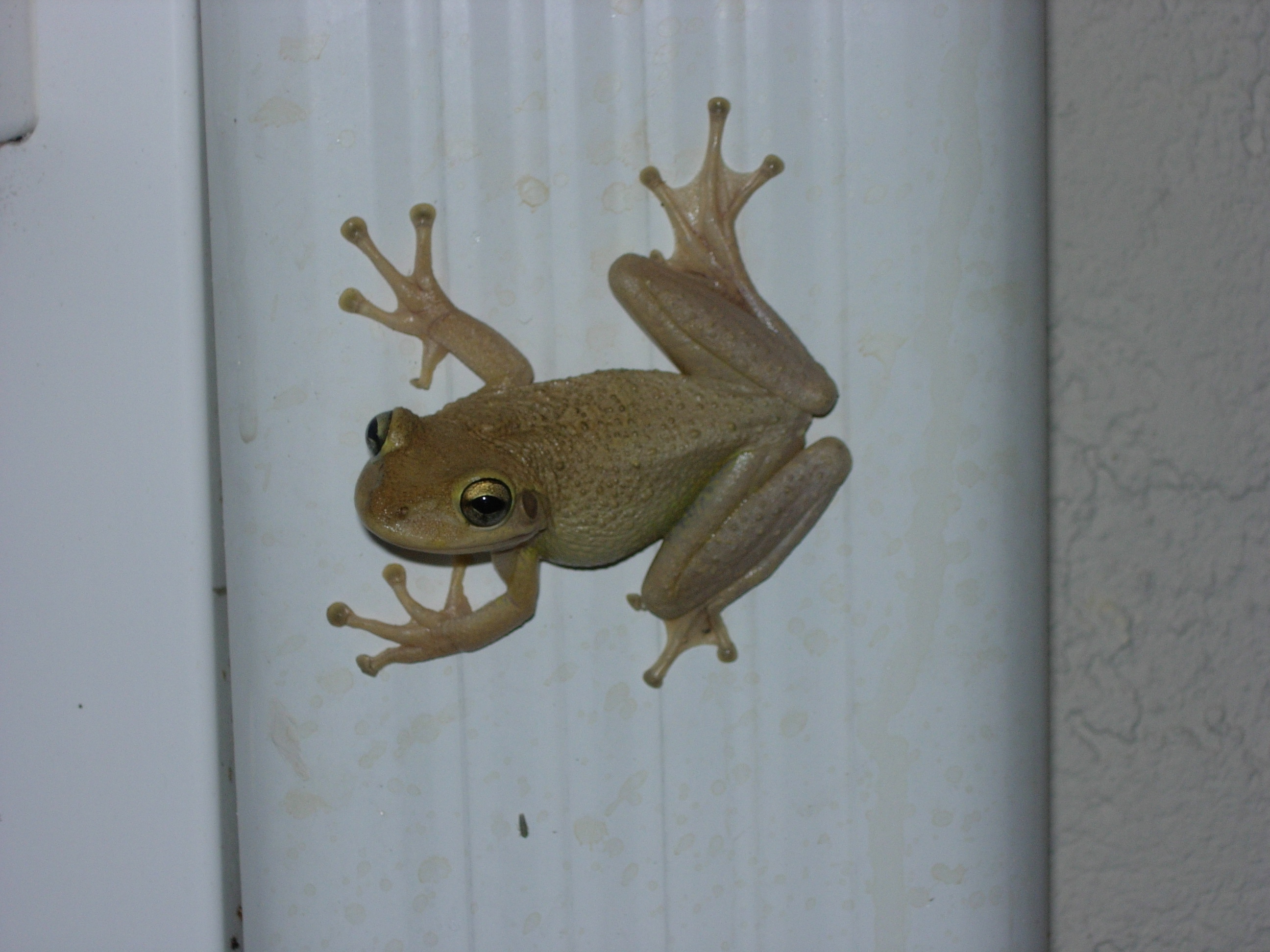
by Rick O'Connor | Feb 5, 2021
EDRR Invasive Species
Cuban Treefrog (Osteopilus septentrionalis)

Cuban Tree Frog. Photo credit: Steve Johnson
Define Invasive Species: must have ALL of the following –
- Is non-native to the area, in our case northwest Florida
- Introduced by humans, whether intentional or accidental
- Causing either an environmental or economic problem, possibly both
Define EDRR Species: Early Detection Rapid Response. These are species that are either –
- Not currently in the area, in our case the Six Rivers CISMA, but a potential threat
- In the area but in small numbers and could be eradicated
Native Range:
Cuban Treefrog is native to Cuba, Cayman Islands, and the Bahamas.
Introduction:
Accidental introduction in the 1920s most likely by container, or cargo ships.
EDDMapS currently list 1,953 records of this frog. Most are in Florida, and the majority of those in central and south Florida. However, there are records from Louisiana, Georgia, Tennessee, New York, and Massachusetts. Again, most likely cause of spread is hitchhiking on trucks carrying ornamental plants from nurseries in south Florida.
Within our region there are 15 records. 4 in Pensacola Bay area, 3 in Panama City Bay area, 3 from the Tallahassee area, 2 from Crawfordville, and one record from each Crestview, Marianna, and Blountstown.
There is a report of a breeding colony in the Panama City area that has not been confirmed.
There are five records within Six Rivers CISMA. Four in the Pensacola Bay area and one in Crestview.
Description:
Cuban treefrogs are first, treefrogs. Treefrogs can be identified by their large toepads used to hold on to trees and buildings. Cuban treefrog toepads are relatively larger than the native treefrogs.
Adults are much larger than native treefrogs. Local frogs will range from 1-4” but Cuban Treefrogs can reach 6”. They have rough-warty skin, but colors vary greatly. There are usually patterns of dark markings on body, but they do not have the distinct spots of the Barking treefrog. There is a yellowish color where the front and hind legs meet on the body. The eyes can be large and “bugged-out” in appearance.
The most likely native to confuse it with is the Copes gray treefrog. Both have varied colors and warty skin. Both of have the yellow color on skin near where legs join the body. However, the Copes gray treefrog will have a light-colored blotch below each eye. Also, they do not reach the large size of the Cuban treefrog.
Juveniles can be distinguished from natives by having a blueish hue to the color of their skeleton when observed from the belly side of the animal.
Issues and Impacts:
Being larger, the Cuban treefrog has been documented as a major predator of at least five species of native frogs. It is also known to consume small native lizards and snakes. The tadpoles of the Cuban treefrog have been found to out compete those of many native frogs in natural waterways.
Once in the yard, they can form very dense populations that have caused problems with “frogs everywhere”, calling at night (their calls sound like a squeaking door), and invading small ponds, water features, and swimming pools. They like to adhere to walls near lights at night to catch insects and can leave nasty stains on walls and windows. They have been known to take over bird and butterfly houses.
Once inside of the house, they can enter pipes and vents creating clogs and enter the bathroom via the toilet. They have been known to hide in electric panels and are large enough to short-circuit systems causing power outages, air conditioning, and water pump issues.
They are poisonous. And though there are no deaths attributed to them, they can cause an itching-burning sensation in people that can last over an hour. They have caused some pets to go into seizures and foam at the mouth, but no deaths have been reported.
Management:
First you must find them. Being primarily nocturnal, Cuban treefrogs will climb high into trees and spend the daylight hours awaiting sunset. They can crawl into gaps in the wall, under boards and structures, in bird and butterfly houses. One method of capture is to place 3’ sections of 1.5” PVC pipe into the ground near walls where treefrogs gather at night. Many species of treefrogs will use these pipes as hiding places during daylight hours. If there are frogs in the PVC, you can cover the top with a plastic sandwich bag, pull from the ground holding the bottom of the pipe closed with your hand. Have a partner use a stick, or broom handle, and force frogs into the bag. Once there, you can identify them.
If you have a Cuban treefrog (see identification above) there are two methods recommended to euthanize them. 1) You can zip the sandwich bag closed and place in the refrigerator for 3-4 hours. This cooling will numb their nervous system. The bag can then be transferred into a freezer for 24 hours and which time the animal is now dead. 2) Place a 1” strip of benzocaine along their back. Rub this in and wait for the animal to become numb. You can now place back into the bag and into a freezer for 24 hours. REMEMBER, WASH YOUR HANDS AFTER HANDLING A CUBAN TREEFROG. IF YOU GLOVES, WEAR THEM.
It is important to make sure you have identified the frog correctly before euthanizing it. If you have questions, contact your county extension office and have good photos of the animal. If you are in the Florida panhandle area, and it is a Cuban treefrog, please contact your county extension office to let them know and report the siting to www.EDDMapS.org. If you have questions on how to do this, your county extension office can help.
For more information on this EDRR species, contact your local extension office.
References
Invasive Cuban Treefrogs in Florida. Dr. Steve Johnson. University of Florida Department of Wildlife Ecology and Conservation.
https://ufwildlife.ifas.ufl.edu/cuban_treefrog_inFL.shtml.
Cuban Treefrog (Osteopilus septentrionalis) in Florida. Dr. Steve Johnson. University of Florida Department of Wildlife Ecology and Conservation. UF IFAS Extension EDIS publication #WEC218.
https://edis.ifas.ufl.edu/uw259.
Early Detection and Distribution Mapping System (EDDMapS)
https://www.eddmaps.org/
Six Rivers CISMA
https://www.floridainvasives.org/sixrivers/

by Rick O'Connor | Jan 22, 2021
Continuing our monthly series of invasive species articles – this week we look at the first of the “Dirty Dozen”. The Dirty Dozen are the 12 worst, most problematic, established invasive species within the Six Rivers CISMA – as decided by the members of the Six Rivers CISMA. This month we look at the Japanese Climbing Fern (Lygodium japanicum).

Japanese Climbing Fern can quickly cover natural vegetation. Spores and small plants can be potentially transported in pine straw. Climbing ferns are a problem for managed timber and home landscapes. Photo by L. Scott Jackson
Define Invasive Species: must have all of the following –
- Is non-native to the area, in our case northwest Florida
- Introduced by humans, whether intentional or accidental
- Causing either an environmental or economic problem, possibly both
Define “Dirty Dozen” Species:
These are species that are well established within the CISMA and are considered, by members of the CISMA, to be one of the top 12 worst problems in our area.
Native Range:
Japanese Climbing Fern is from eastern Asia.
Introduction:
The plant was introduced by humans intentionally in the 1930s as an ornamental plant.
EDDMapS currently list 28,649 records of this plant. Most are in the coastal states of the southeastern U.S.
Within our CISMA there are 3148 records. This is CERTAINLY underreported.
Description:
Japanese Climbing Fern is vine that grows from rhizomes below the ground. The stems and rhizomes are very thin and wire like. The leaves can be flat and finger-like to “lacey” and “feather-like” and are opposite on the vine. The broader leaves carry the sporangia housing the spores. The spores are very tiny and can be carried by the wind and by your clothes. The vines will develop massive thick mats covering fences, sides of buildings, and much of the native vegetation in the area. In winter the vines, and leaves, appear brown and dead, but they are not. It grows well in sun or shade, damp areas that have been disturbed but grows just as well in areas that have not been disturbed.
Issues and Impacts:
This plant forms massive dense mats that can completely cover all native vegetation in the area. This matting can reduce sunlight to existing plants and reduce their ability to germinate seedlings. The vines are known to grow as high as 90 feet into the tree canopy. The plant has been a problem for the timber industry trying to collect pine straw for sale. It was listed as a Florida Noxious Weed in 1999.
Management:
Hand removal, or any other means of mechanical removal, has not been effective.
Burning does kill the above ground biomass, but the below ground biomass usually returns the plant.
Puccinia lygodii, a rust found on many species of Lygodium, may be a biological control. Studies on this continue.
Chemical treating with a 2-3% solution of Glyphosate has been effective.
Any management of this plant should be done in the late summer/early fall when the spores are not present.
For more information on this EDRR species, contact your local extension office.
References
Japanese Climbing Fern, University of Florida IFAS Center for Aquatic and Invasive Plants
https://plants-archive.ifas.ufl.edu/plant-directory/lygodium-japonicum/
Early Detection and Distribution Mapping System (EDDMapS)
https://www.eddmaps.org/
Six Rivers CISMA
https://www.floridainvasives.org/sixrivers/
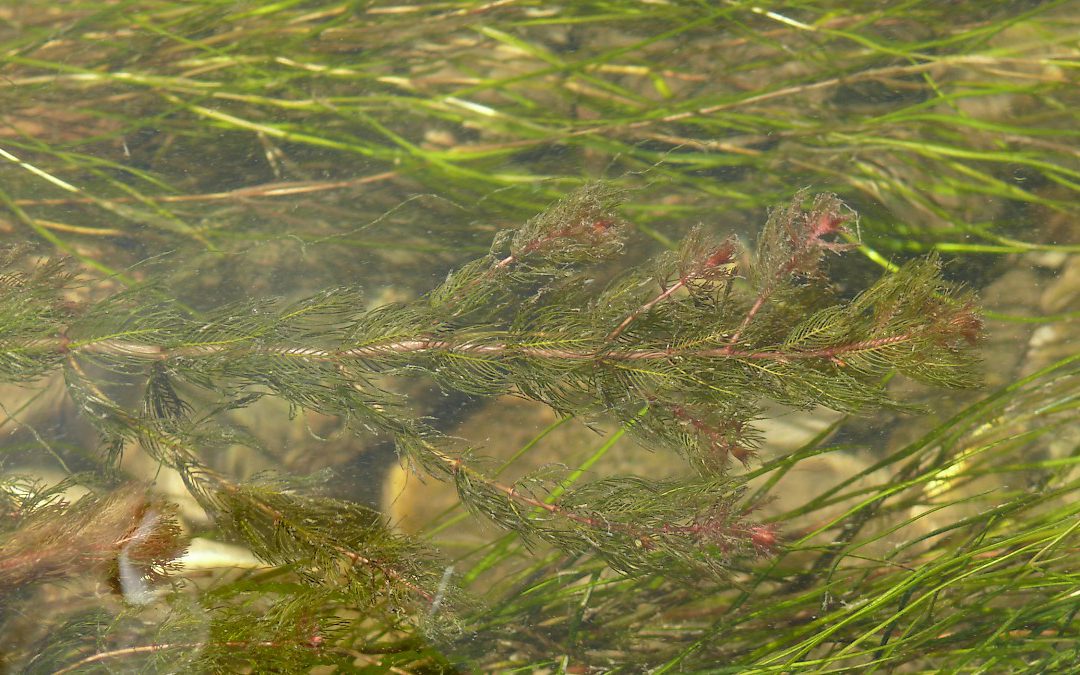
by Rick O'Connor | Jan 13, 2021
EDRR Invasive Species
Eurasian Milfoil (Myriophyllum spicatum)
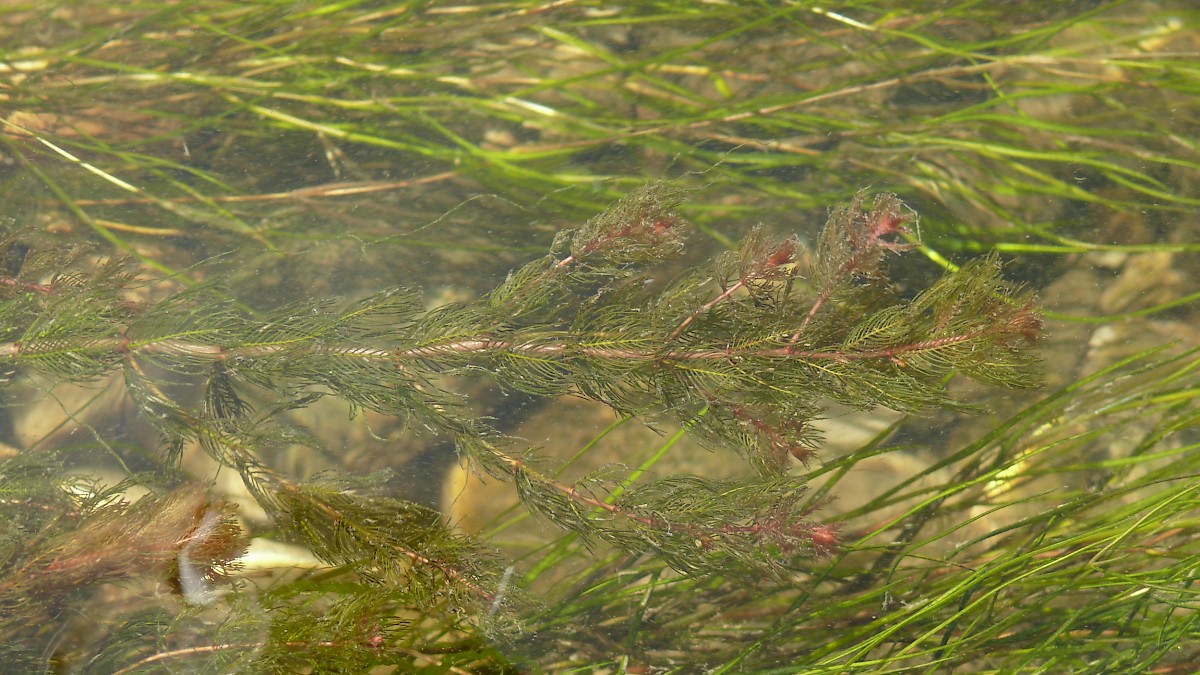
Eurasian milfoil.
Photo: University of Florida
Define Invasive Species: must have all of the following –
- Is non-native to the area, in our case northwest Florida
- Introduced by humans, whether intentional or accidental
- Causing either an environmental or economic problem, possibly both
Define EDRR Species: Early Detection Rapid Response. These are species that are either –
- Not currently in the area, in our case the Six Rivers CISMA, but a potential threat
- In the area but in small numbers and could be eradicated
Native Range:
Eurasian milfoil is native to Eurasia and north Africa.
Introduction:
There are two records of its possible introduction.
- Introduced accidentally in ship ballast entering the Chesapeake Bay in the late 1800s.
- Intentionally introduced in the Chesapeake Bay area in 1942.
EDDMapS currently list 20,532 records of this plant. Most are along the U.S. Canadian border.
Within our region there are 24 records. 11 in Bainbridge GA, one in Panama City, four in Apalachicola, and seven in south Alabama.
There are five records within Six Rivers CISMA, all in the Mobile delta.
Description:
Eurasian milfoil is a submerged, rooted, freshwater plant preferring slow moving waters.
It has long slender stems that are reddish-brown to whiteish-pink in color branching as it reaches the surface. The leaves are olive-green in color, less than 2” in length, and branching (feather-like). Leaf whorls along the stem are between 3-6 leaves but typically 4. Whorl nodes are 3/8” apart.
Flowers are reddish and attached to emersed spikes reaching above the water. The spike is about 8” long and the flowers are arranged in a whorl pattern around this. In Canada it flowers in late July and early August.
It can tolerate salinities up to 10 ppt and could be found in upper brackish systems.
The plant can grow in 20 feet of water but is most often found in waters less than 10 feet deep.
It can grow into large, dense mats, and can be the most common plant in the area.
Issues and Impacts:
Has been known to stop boat traffic.
Can completely cover the surface of the water reducing oxygen exchange and light for other submerged plants. Decaying mats can reduce dissolved oxygen even further.
Has been reported to negatively impact fish and birds.
Management:
Mechanical harvesters and chopping machines have been used but fragments can re-sprout.
Underwater vacuuming has been tried in Canada.
In bodies of water where this can be done, water draw down has been effective.
Biological controls using fish and insects have had some success.
Aquatic herbicides have been used to help control but rarely eradicate the plant completely.
EDUCATE BOATERS TO CHECK THEIR BOATS AND TRAILERS WHEN ENTERING AND LEAVING WATER BODIES WHERE EURASIAN MILFOIL MIGHT EXIST.
DO NOT DISCHARGE UNWANTED AQUARIUM PLANTS INTO LOCAL WATERWAYS.
It is currently not listed as a federal noxious weed and continues to be sold as a plant for aquariums.
For more information on this EDRR species, contact your local extension office.
References
Eurasian milfoil, University of Florida IFAS Center for Aquatic and Invasive Plants
https://plants-archive.ifas.ufl.edu/plant-directory/myriophyllum-spicatum/
Early Detection and Distribution Mapping System (EDDMapS)
https://www.eddmaps.org/
Six Rivers CISMA
https://www.floridainvasives.org/sixrivers/







